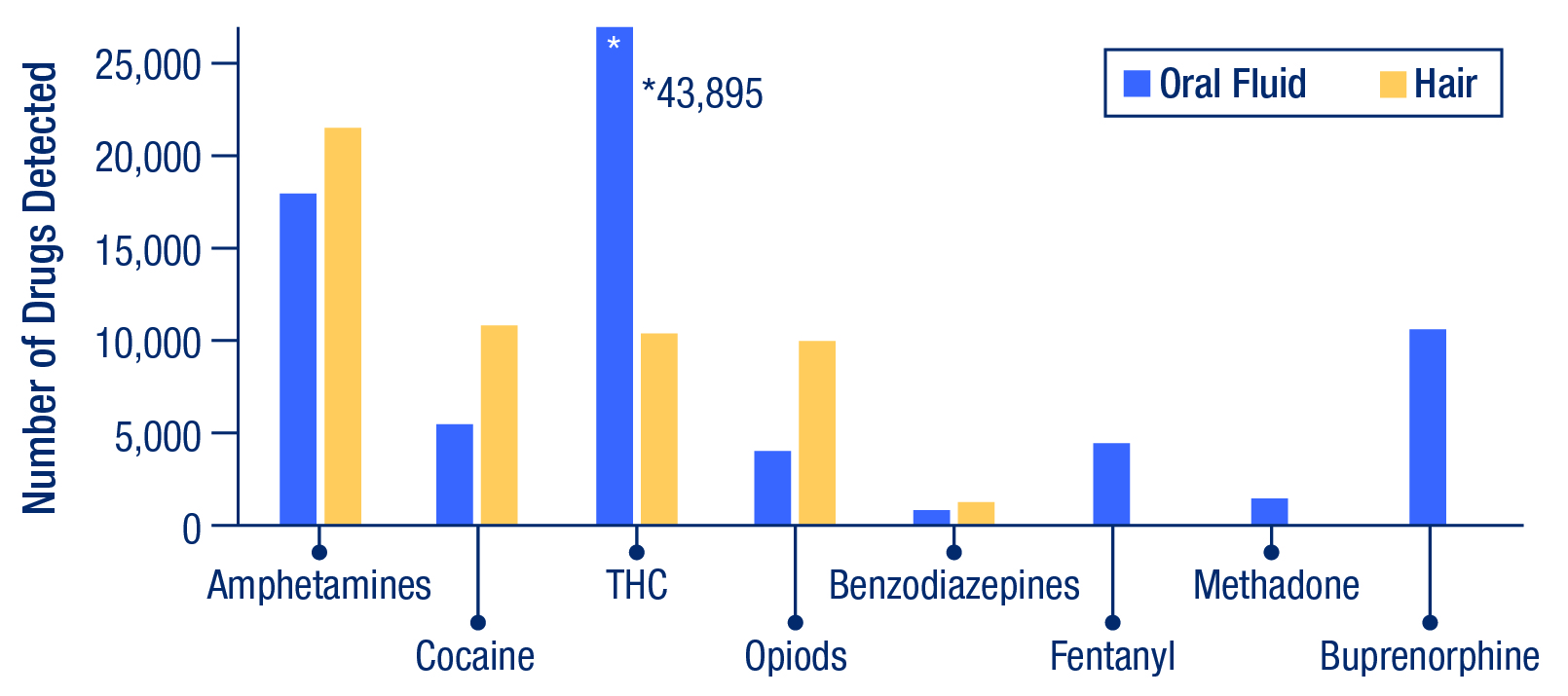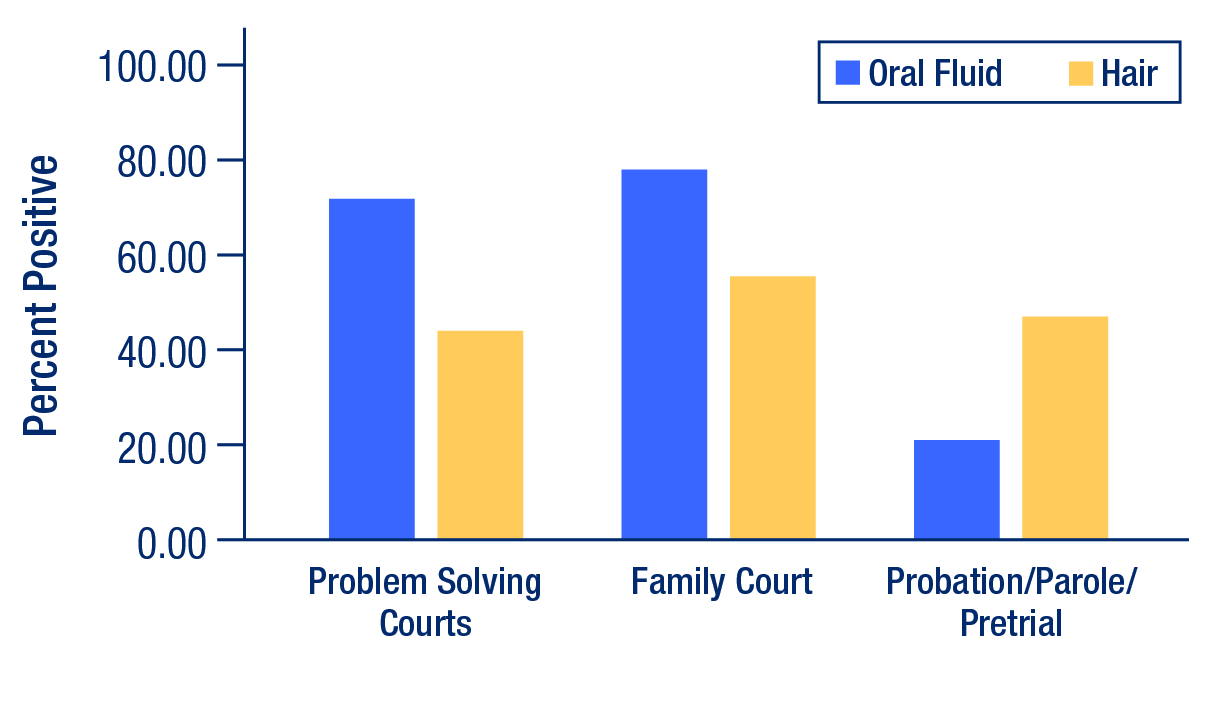Public health officials rely on drug prevalence data to understand and address drug-related harms in communities. Tracking patterns in substance use can help identify new trends, offer early indications of emerging drugs, and enable effective intervention and treatment strategies. Helpfully, since 2013 both law enforcement drug seizures[1] and court-ordered mandatory drug testing have steadily increased, resulting in a sizeable database from which to study drug use patterns. Given the intersection of public health and criminal justice systems in the context of unlawful drug use, it is essential that drug prevalence data are accurate. This is particularly crucial given the soaring rates of opioid-related overdoses, fueled in large part by the introduction of highly potent fentanyl and related analogs.
Forensic toxicologists usually analyze urine or oral fluid for court-ordered mandatory drug testing. However, these tests only detect use during a short window of time (usually less than a week). Drug testing hair offers a longer window to detect use (generally up to a few months), but these tests do not typically search for fentanyl or fentanyl-related compounds. Law enforcement and policymakers need timely, evidence-based intelligence of drug prevalence in criminal justice populations, including patterns of fentanyl and fentanyl-related compounds. This will help inform prevention and enforcement strategies, improve public health measures, and help increase compliance with probation and parole conditions.
Researchers Megan Grabenauer and Nichole Bynum aimed to develop a better understanding of fentanyl prevalence in populations under court-ordered mandatory drug testing using a three-step approach. First, they determined the pervasiveness of fentanyl and a selection of fentanyl-related compounds in hair specimens submitted for such testing. They then compared results from court-ordered mandatory drug testing to results from the general workforce who were also tested for drug use. Finally, they conducted a six-year retrospective analysis comparing results for oral fluids and hair samples.
Prevalence of Fentanyl and Other Compounds in Hair Samples
To discern the prevalence of fentanyl and related compounds in hair samples, the researchers used mass spectrometry[2] on 520 hair samples collected under court-ordered mandatory drug tests over a six-month period (late 2020 through early 2021) (Figure 1). They noted hair length, color, and curl type.[3] Samples positive for fentanyl were further examined for additional compounds.
Figure 1. Fentanyl-related compounds and other compounds included in the researchers’ mass spectrometry detection method. The internal standards are listed in parentheses.
| Fentanyl and Fentanyl-Related Compounds and Internal Standards | Opioids and Other Compounds and Internal Standards |
|---|---|
4-ANPP (4-ANPP-d5) para-Fluoro 4-ANPP Fentanyl (Fentanyl-d5) Acetyl fentanyl (Acetyl fentanyl-d5) Acetyl norfentanyl (Acetyl norfentanyl-d5) Benzylfentanyl Carfentanil (Carfentanil-d5) Chlorofentanyl para-Fluorobutyryl fentanyl 4-Fluoroisobutyryl fentanyl Fluorofentanyl Norfentanyl (Norfentanyl-d5) Phenyl fentanyl (Phenyl fentanyl-d5) Phenethyl 4-ANPP Valeryl fentanyl (Valeryl fentanyl-d5) | 6-Acetylmorphine (6-Acetylmorphine-d6) Benzoylecgonine (Benzoylecgonine-d3) Buprenorphine Cocaine (Cocaine-d3) Codeine (Codeine-d3) Hydrocodone (Hydrocodone-d6) Methamphetamine (Methamphetamine-d9) Methadone (Methadone-d9) Morphine (Morphine-d6) Oxycodone (Oxycodone-d6) Oxymorphone (Oxymorphone-d3) Tramadol Xylazine |
Key findings:
- The overall drug positivity rate in the 520 hair specimens was 54%.
- Methamphetamine was most common (27%), followed by oxycodone (15%).
- Fentanyl was the most common fentanyl-related compound (15%), followed by 4-ANPP (7%)[4].
- The “fentanyl alone” positivity rate (that is, the samples that were positive for only fentanyl or fentanyl-related compounds) was 2.9%. These samples would have been considered negative by current court-ordered mandatory drug testing practices, which do not include fentanyl or fentanyl-related compounds.
- Hair specimens with obvious false hair colors had a much higher overall positivity rate of 74% than natural hair color (compared to natural light blonde (59%), natural medium (52%), and natural dark (53%)).[5]
- There was no statistically significant difference between overall positivity rates for differing hair lengths or curl types.
Six-Year Retrospective Analysis
To further characterize drug use patterns and compare results from court-ordered mandatory drug tests to workforce test results, the researchers also conducted a retrospective analysis of court-ordered mandatory drug test results from a commercial toxicology laboratory.[6] The data from a six-year period (February 1, 2016 to February 28, 2022) screened oral fluid samples (n= 959,237)[7] and hair samples (n= 62,258).
How do drug test results among the population under court-ordered mandatory drug testing compare to those of the general workforce?
- The overall oral fluid drug positivity rate for those under court-ordered testing was 34% and overall hair drug positivity rate was 56%.
- These rates were up to five times higher than the general U.S. workforce population (10.0% for oral fluid and 10.4% for hair) during a similar time.[8]
- The average oral fluid positivity rate across five years (2013–2017) for the workforce “for cause”[9] testing was higher than that of the general U.S. workforce population (28.2%).
How does drug detection in the population under court-ordered drug testing change when the screening includes fentanyl and fentanyl-related compounds?
- Of the 69,073 oral fluid specimens confirmed positive for any drug, 4,367 (6.3%) were positive for fentanyl or fentanyl-related compounds.
- The substances most often found in combination with fentanyl were amphetamines, cocaine, and tetrahydrocannabinol (THC) a main chemical component of marijuana. Among the samples, 1,492 (2.2%) were positive for fentanyl alone (meaning no other drugs were found). This aligns with researchers’ in-house testing of hair specimens, in which 2.9% of specimens were positive only for fentanyl or fentanyl-related compounds.
- The percent of tests positive only for fentanyl was 1.9% in 2020, 2.1% in 2021, and 3.3% in 2022. The increase from 2021 to 2022 was statistically significant (p < 0.01).
Oral Fluid Versus Hair Tests
Researchers compared oral fluid and hair test results and found that different drugs were detected by each.[10]
- In oral fluid samples, the top five most frequently identified drugs in confirmation testing were THC (64%), amphetamines, (26%), buprenorphine (15%), cocaine (7%), and fentanyl (6%) (Figure 2).
- In hair samples, the top five were amphetamines (59%), cocaine (30%), THC (28%), opioids (27%), and benzodiazepines (3%) (Figure 2).
Researchers also examined these results by court type and community supervision status. Tests of oral fluid and tests of hair samples both indicated that family court produced the largest proportion of positive results (Figure 3). The proportion of positive tests results was greater based on oral fluid than hair (Figure 4) for family court and problem-solving courts.
Figure 2. The most common drugs detected in court-ordered mandatory drug testing oral fluid and hair testing.
Figure 3. Positivity rates of oral fluid and hair tests, by court type.
Figure 4. Positivity rates for problem-solving courts, family courts, and probation/parole/pretrial, based on oral fluid and hair.
Policy Implications
According to Grabenauer, “This project provides actionable information from numerous, geographically diverse U.S. jurisdictions. To the best of our knowledge, it is the first large-scale drug prevalence study in a [court-ordered mandatory drug testing] population and provides a view of drug combinations in this population, specifically fentanyl and fentanyl-related compounds in combination with other substances.”
Prevalence data shapes drug policy at the federal, state, and local levels and informs drug reduction strategies. The data provided by this NIJ-funded research could be used in several different ways:
- To be an early indicator of shifting drug use trends for public safety and public health agencies.
- To contextualize other drug use indicator data, such as the National Survey on Drug Use and Health (NSDUH).[11]
- To inform policymakers and other stakeholders about decisions to update routine testing protocols.
- To advance the use of hair testing for fentanyl-related compounds.
About This Article
The work described in this article was supported by NIJ award number 2019-R2-CX-0017, awarded to RTI International. This article is based on the grantee report “Prevalence of Fentanyl and Its Analogues in a Court-Ordered Mandatory Drug Testing Population” (pdf, 23 pages), by Megan Grabenauer, Ph.D. and Nichole Bynum.




